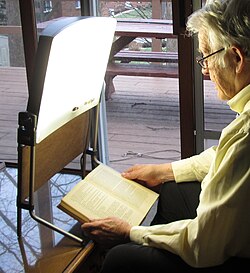Seasonal affective disorder

Editor-In-Chief: Prab R Tumpati, MD
Obesity, Sleep & Internal medicine
Founder, WikiMD Wellnesspedia &
W8MD medical weight loss NYC and sleep center NYC
| Seasonal affective disorder | |
|---|---|

| |
| Synonyms | N/A |
| Pronounce | N/A |
| Specialty | N/A |
| Symptoms | Depression, lethargy, hypersomnia, overeating, weight gain, social withdrawal |
| Complications | N/A |
| Onset | Typically in autumn and winter |
| Duration | Symptoms usually resolve in spring and summer |
| Types | N/A |
| Causes | Reduced sunlight exposure |
| Risks | Family history, bipolar disorder, living far from the equator |
| Diagnosis | Based on clinical assessment |
| Differential diagnosis | Major depressive disorder, bipolar disorder, hypothyroidism |
| Prevention | N/A |
| Treatment | Light therapy, cognitive behavioral therapy, antidepressants |
| Medication | N/A |
| Prognosis | N/A |
| Frequency | More common in women and young adults |
| Deaths | N/A |
File:Seasonal affective disorder (Depressive Disorder with Seasonal Pattern).webm
Seasonal affective disorder (SAD), also known as winter depression, is a type of depression that comes and goes in a seasonal pattern. SAD is sometimes known as "winter depression" because the symptoms are usually more apparent and more severe during the winter.
Symptoms[edit]
The symptoms of SAD often begin in the fall as the days start getting shorter. They're typically most severe in the months of December, January, and February. SAD often goes away in the spring and summer. If it doesn't, you may have a different type of depression. Symptoms of SAD can include:
- a persistent low mood
- a loss of pleasure or interest in normal everyday activities
- irritability
- feelings of despair, guilt and worthlessness
- feeling lethargic (lacking in energy) and sleepy during the day
- sleeping for longer than normal and finding it hard to get up in the morning
- craving carbohydrates and gaining weight
Causes[edit]
The exact cause of SAD isn't fully understood, but it's often linked to reduced exposure to sunlight during the shorter autumn and winter days. The main theory is that a lack of sunlight might stop a part of the brain called the hypothalamus working properly, which may affect the production of melatonin, serotonin, and the body's internal clock (circadian rhythm).
Treatment[edit]
Treatments for SAD can include light therapy, talking therapies such as cognitive behavioral therapy or counseling, and antidepressant medication.
See also[edit]
- Depression (mood)
- Bipolar disorder
- Major depressive disorder
- Dysthymia
- Circadian rhythm sleep disorder
References[edit]
<references />
External links[edit]
Ad. Transform your life with W8MD's Budget GLP-1 injections from $75


W8MD offers a medical weight loss program to lose weight in Philadelphia. Our physician-supervised medical weight loss provides:
- Weight loss injections in NYC (generic and brand names):
- Zepbound / Mounjaro, Wegovy / Ozempic, Saxenda
- Most insurances accepted or discounted self-pay rates. We will obtain insurance prior authorizations if needed.
- Generic GLP1 weight loss injections from $75 for the starting dose.
- Also offer prescription weight loss medications including Phentermine, Qsymia, Diethylpropion, Contrave etc.
NYC weight loss doctor appointmentsNYC weight loss doctor appointments
Start your NYC weight loss journey today at our NYC medical weight loss and Philadelphia medical weight loss clinics.
- Call 718-946-5500 to lose weight in NYC or for medical weight loss in Philadelphia 215-676-2334.
- Tags:NYC medical weight loss, Philadelphia lose weight Zepbound NYC, Budget GLP1 weight loss injections, Wegovy Philadelphia, Wegovy NYC, Philadelphia medical weight loss, Brookly weight loss and Wegovy NYC
|
WikiMD's Wellness Encyclopedia |
| Let Food Be Thy Medicine Medicine Thy Food - Hippocrates |
Medical Disclaimer: WikiMD is not a substitute for professional medical advice. The information on WikiMD is provided as an information resource only, may be incorrect, outdated or misleading, and is not to be used or relied on for any diagnostic or treatment purposes. Please consult your health care provider before making any healthcare decisions or for guidance about a specific medical condition. WikiMD expressly disclaims responsibility, and shall have no liability, for any damages, loss, injury, or liability whatsoever suffered as a result of your reliance on the information contained in this site. By visiting this site you agree to the foregoing terms and conditions, which may from time to time be changed or supplemented by WikiMD. If you do not agree to the foregoing terms and conditions, you should not enter or use this site. See full disclaimer.
Credits:Most images are courtesy of Wikimedia commons, and templates, categories Wikipedia, licensed under CC BY SA or similar.
Translate this page: - East Asian
中文,
日本,
한국어,
South Asian
हिन्दी,
தமிழ்,
తెలుగు,
Urdu,
ಕನ್ನಡ,
Southeast Asian
Indonesian,
Vietnamese,
Thai,
မြန်မာဘာသာ,
বাংলা
European
español,
Deutsch,
français,
Greek,
português do Brasil,
polski,
română,
русский,
Nederlands,
norsk,
svenska,
suomi,
Italian
Middle Eastern & African
عربى,
Turkish,
Persian,
Hebrew,
Afrikaans,
isiZulu,
Kiswahili,
Other
Bulgarian,
Hungarian,
Czech,
Swedish,
മലയാളം,
मराठी,
ਪੰਜਾਬੀ,
ગુજરાતી,
Portuguese,
Ukrainian


